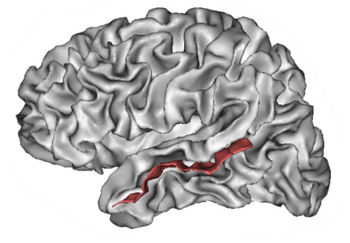Superior temporal sulcus: Difference between revisions
Jump to navigation
Jump to search


John Leach (talk | contribs) m (Text replacement - "auditory cortex" to "auditory cortex") |
mNo edit summary |
||
| Line 3: | Line 3: | ||
The '''Superior temporal sulcus''' (commonly abbreviated STS) is the dorsal one of the usually two [[sulcus (neuroanatomy)|sulci]] in the [[temporal lobe]] of the [[primate brain]]. It separates the [[superior temporal gyrus|superior temporal]] from the [[middle temporal gyrus|middle temporal]] [[gyrus]] and extends anteriorly until the [[temporal pole]], with a highly [[cortical variability|variable]] posterior end. | The '''Superior temporal sulcus''' (commonly abbreviated STS) is the dorsal one of the usually two [[sulcus (neuroanatomy)|sulci]] in the [[temporal lobe]] of the [[primate brain]]. It separates the [[superior temporal gyrus|superior temporal]] from the [[middle temporal gyrus|middle temporal]] [[gyrus]] and extends anteriorly until the [[temporal pole]], with a highly [[cortical variability|variable]] posterior end. | ||
Part of the superior temporal sulcus belongs to the auditory cortex and as such, it is involved in [[speech perception]] and [[music perception]]. It also plays a central role in [[face perception]] and, more generally, in [[multisensory processing]]. | Part of the superior temporal sulcus belongs to the auditory cortex and as such, it is involved in [[speech perception]] and [[music perception]]. It also plays a central role in [[face perception]] and, more generally, in [[multisensory processing]].[[Category:Suggestion Bot Tag]] | ||
Latest revision as of 11:01, 23 October 2024

(CC) Image: Lefèvre and Mangin, 2010
The central surface of the human brain, with the superior temporal sulcus highlighted.
The central surface of the human brain, with the superior temporal sulcus highlighted.
The Superior temporal sulcus (commonly abbreviated STS) is the dorsal one of the usually two sulci in the temporal lobe of the primate brain. It separates the superior temporal from the middle temporal gyrus and extends anteriorly until the temporal pole, with a highly variable posterior end.
Part of the superior temporal sulcus belongs to the auditory cortex and as such, it is involved in speech perception and music perception. It also plays a central role in face perception and, more generally, in multisensory processing.